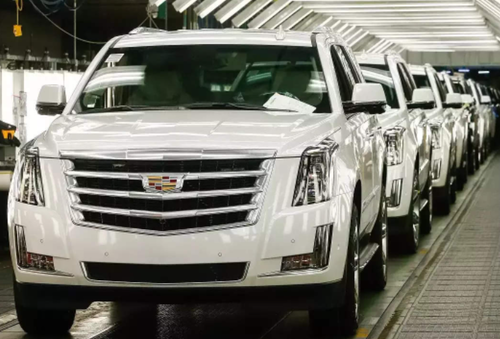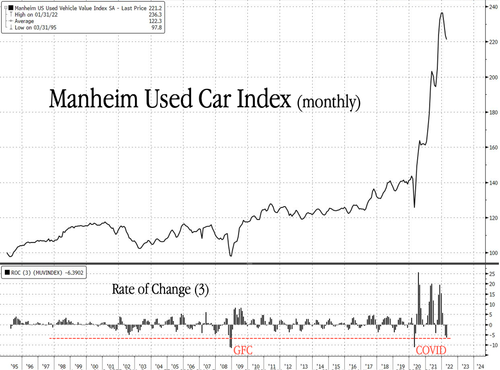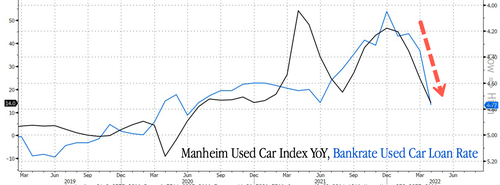
Auto sales numbers for May are starting to trickle in and they're ugly...
The lack of stimmy money and unemployment check bonuses, combined with the fact that rates are rising and spending is slowing, made for a tumultuous May report for some of the most well known legacy auto manufacturers.
Here's a look at four of the first names to hit the tape this week, with most other major auto manufacturers set to release data within the next day or so.
*HONDA MAY U.S. AUTO SALES -57.3%
*TOYOTA US MAY SALES 175,990, -27.3% Y/Y
*MAZDA N. AMERICA MAY SALES DOWN 63.7%
*NISSAN APRIL GLOBAL SALES -29.1%
It's going to be tough to keep the melt-up in auto prices going with sales slowing down so much. Over the last year, both new and used car prices have soared amidst growing demand and a gummed up supply chain that keep inventory sparse.
Inventory looks like it could be less of an issue over the next few months, based on May's numbers. Remember, we wrote in the beginning of May that used car prices were crashing at a near record pace.
As we noted then, the Manheim Used Vehicle Value Index, a wholesale tracker of used car prices, printed the most significant monthly decline in terms of rate of change averaged out over three months in April at 6.4%. It didn't beat the April 2020 print of -11.2% nor December 2008 of -11.5%, but those two periods were in full-blown financial crises.
The Fed routinely says monetary tightening will create a soft-landing, similar to the mid-90s. However, tightening financial conditions could only spark trouble for an economy based 70% on consumption and driven by access to cheap credit. The cooling in the used car market could suggest a broader economic slowdown is ahead.
We also noted in May the used car market year-over-year growth rates versus used car auto loan rates. A jump in rates has dampened upward price pressure as fewer buyers can afford cars. This is likely part of what has contributed to May's terrible retail sales numbers.
Additionally, according to a report out Wednesday by The Verge, GM is also slashing prices on their 2023 Chevy Bolt EV and EUV.
Hilariously, GM's PR department is definitely doing their job well, as they put the "spin" on the lowered pricing as a measure being taken "amid high demand". GM says it wants to send the message that “affordability has always been a priority for these vehicles", the Verge wrote.
A GM spokesperson said: “This change reflects our ongoing desire to make sure Bolt EV/EUV are competitive in the marketplace.”
Because we all know that high demand drives prices...lower...right?
Auto sales numbers for May are starting to trickle in and they’re ugly…
The lack of stimmy money and unemployment check bonuses, combined with the fact that rates are rising and spending is slowing, made for a tumultuous May report for some of the most well known legacy auto manufacturers.
Here’s a look at four of the first names to hit the tape this week, with most other major auto manufacturers set to release data within the next day or so.
*HONDA MAY U.S. AUTO SALES -57.3%
*TOYOTA US MAY SALES 175,990, -27.3% Y/Y
*MAZDA N. AMERICA MAY SALES DOWN 63.7%
*NISSAN APRIL GLOBAL SALES -29.1%
It’s going to be tough to keep the melt-up in auto prices going with sales slowing down so much. Over the last year, both new and used car prices have soared amidst growing demand and a gummed up supply chain that keep inventory sparse.
Inventory looks like it could be less of an issue over the next few months, based on May’s numbers. Remember, we wrote in the beginning of May that used car prices were crashing at a near record pace.
As we noted then, the Manheim Used Vehicle Value Index, a wholesale tracker of used car prices, printed the most significant monthly decline in terms of rate of change averaged out over three months in April at 6.4%. It didn’t beat the April 2020 print of -11.2% nor December 2008 of -11.5%, but those two periods were in full-blown financial crises.
The Fed routinely says monetary tightening will create a soft-landing, similar to the mid-90s. However, tightening financial conditions could only spark trouble for an economy based 70% on consumption and driven by access to cheap credit. The cooling in the used car market could suggest a broader economic slowdown is ahead.
We also noted in May the used car market year-over-year growth rates versus used car auto loan rates. A jump in rates has dampened upward price pressure as fewer buyers can afford cars. This is likely part of what has contributed to May’s terrible retail sales numbers.
Additionally, according to a report out Wednesday by The Verge, GM is also slashing prices on their 2023 Chevy Bolt EV and EUV.
Hilariously, GM’s PR department is definitely doing their job well, as they put the “spin” on the lowered pricing as a measure being taken “amid high demand”. GM says it wants to send the message that “affordability has always been a priority for these vehicles”, the Verge wrote.
A GM spokesperson said: “This change reflects our ongoing desire to make sure Bolt EV/EUV are competitive in the marketplace.”
Because we all know that high demand drives prices…lower…right?








